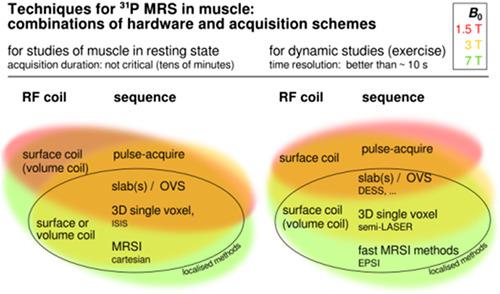当前位置:
X-MOL 学术
›
NMR Biomed.
›
论文详情
Our official English website, www.x-mol.net, welcomes your
feedback! (Note: you will need to create a separate account there.)
31P magnetic resonance spectroscopy in skeletal muscle: Experts' consensus recommendations
NMR in Biomedicine ( IF 2.7 ) Pub Date : 2020-02-10 , DOI: 10.1002/nbm.4246 Martin Meyerspeer 1, 2 , Chris Boesch 3 , Donnie Cameron 4, 5 , Monika Dezortová 6 , Sean C Forbes 7 , Arend Heerschap 8 , Jeroen A L Jeneson 9, 10, 11 , Hermien E Kan 5, 12 , Jane Kent 13 , Gwenaël Layec 13, 14 , Jeanine J Prompers 15 , Harmen Reyngoudt 16 , Alison Sleigh 17, 18, 19 , Ladislav Valkovič 20, 21 , Graham J Kemp 22 ,
NMR in Biomedicine ( IF 2.7 ) Pub Date : 2020-02-10 , DOI: 10.1002/nbm.4246 Martin Meyerspeer 1, 2 , Chris Boesch 3 , Donnie Cameron 4, 5 , Monika Dezortová 6 , Sean C Forbes 7 , Arend Heerschap 8 , Jeroen A L Jeneson 9, 10, 11 , Hermien E Kan 5, 12 , Jane Kent 13 , Gwenaël Layec 13, 14 , Jeanine J Prompers 15 , Harmen Reyngoudt 16 , Alison Sleigh 17, 18, 19 , Ladislav Valkovič 20, 21 , Graham J Kemp 22 ,
Affiliation

|
Skeletal muscle phosphorus‐31 31P MRS is the oldest MRS methodology to be applied to in vivo metabolic research. The technical requirements of 31P MRS in skeletal muscle depend on the research question, and to assess those questions requires understanding both the relevant muscle physiology, and how 31P MRS methods can probe it. Here we consider basic signal‐acquisition parameters related to radio frequency excitation, TR, TE, spectral resolution, shim and localisation. We make specific recommendations for studies of resting and exercising muscle, including magnetisation transfer, and for data processing. We summarise the metabolic information that can be quantitatively assessed with 31P MRS, either measured directly or derived by calculations that depend on particular metabolic models, and we give advice on potential problems of interpretation. We give expected values and tolerable ranges for some measured quantities, and minimum requirements for reporting acquisition parameters and experimental results in publications. Reliable examination depends on a reproducible setup, standardised preconditioning of the subject, and careful control of potential difficulties, and we summarise some important considerations and potential confounders. Our recommendations include the quantification and standardisation of contraction intensity, and how best to account for heterogeneous muscle recruitment. We highlight some pitfalls in the assessment of mitochondrial function by analysis of phosphocreatine (PCr) recovery kinetics. Finally, we outline how complementary techniques (near‐infrared spectroscopy, arterial spin labelling, BOLD and various other MRI and 1H MRS measurements) can help in the physiological/metabolic interpretation of 31P MRS studies by providing information about blood flow and oxygen delivery/utilisation. Our recommendations will assist in achieving the fullest possible reliable picture of muscle physiology and pathophysiology.
中文翻译:

骨骼肌中的 31P 磁共振波谱:专家的共识建议
骨骼肌磷-31 31 P MRS 是应用于体内代谢研究的最古老的 MRS 方法。骨骼肌中31 P MRS 的技术要求取决于研究问题,评估这些问题需要了解相关的肌肉生理学以及31 P MRS 方法如何探测它。在这里,我们考虑与射频激励、 TR、TE 、光谱分辨率、匀场和定位相关的基本信号采集参数。我们为休息和运动肌肉的研究(包括磁化转移)和数据处理提出具体建议。我们总结了可以用31 P MRS 定量评估的代谢信息,无论是直接测量还是通过取决于特定代谢模型的计算得出,并且我们就潜在的解释问题提供建议。我们给出了一些测量量的预期值和容许范围,以及在出版物中报告采集参数和实验结果的最低要求。可靠的检查取决于可重复的设置、受试者的标准化预处理以及对潜在困难的仔细控制,我们总结了一些重要的考虑因素和潜在的混杂因素。我们的建议包括收缩强度的量化和标准化,以及如何最好地考虑异质肌肉募集。我们强调通过分析磷酸肌酸 (PCr) 恢复动力学来评估线粒体功能的一些陷阱。 最后,我们概述了补充技术(近红外光谱、动脉自旋标记、BOLD 和各种其他 MRI 和1 H MRS 测量)如何通过提供有关血流和氧气输送的信息来帮助31 P MRS 研究的生理/代谢解释/利用。我们的建议将有助于尽可能全面、可靠地了解肌肉生理学和病理生理学。
更新日期:2020-02-10
中文翻译:

骨骼肌中的 31P 磁共振波谱:专家的共识建议
骨骼肌磷-31 31 P MRS 是应用于体内代谢研究的最古老的 MRS 方法。骨骼肌中31 P MRS 的技术要求取决于研究问题,评估这些问题需要了解相关的肌肉生理学以及31 P MRS 方法如何探测它。在这里,我们考虑与射频激励、 TR、TE 、光谱分辨率、匀场和定位相关的基本信号采集参数。我们为休息和运动肌肉的研究(包括磁化转移)和数据处理提出具体建议。我们总结了可以用31 P MRS 定量评估的代谢信息,无论是直接测量还是通过取决于特定代谢模型的计算得出,并且我们就潜在的解释问题提供建议。我们给出了一些测量量的预期值和容许范围,以及在出版物中报告采集参数和实验结果的最低要求。可靠的检查取决于可重复的设置、受试者的标准化预处理以及对潜在困难的仔细控制,我们总结了一些重要的考虑因素和潜在的混杂因素。我们的建议包括收缩强度的量化和标准化,以及如何最好地考虑异质肌肉募集。我们强调通过分析磷酸肌酸 (PCr) 恢复动力学来评估线粒体功能的一些陷阱。 最后,我们概述了补充技术(近红外光谱、动脉自旋标记、BOLD 和各种其他 MRI 和1 H MRS 测量)如何通过提供有关血流和氧气输送的信息来帮助31 P MRS 研究的生理/代谢解释/利用。我们的建议将有助于尽可能全面、可靠地了解肌肉生理学和病理生理学。











































 京公网安备 11010802027423号
京公网安备 11010802027423号